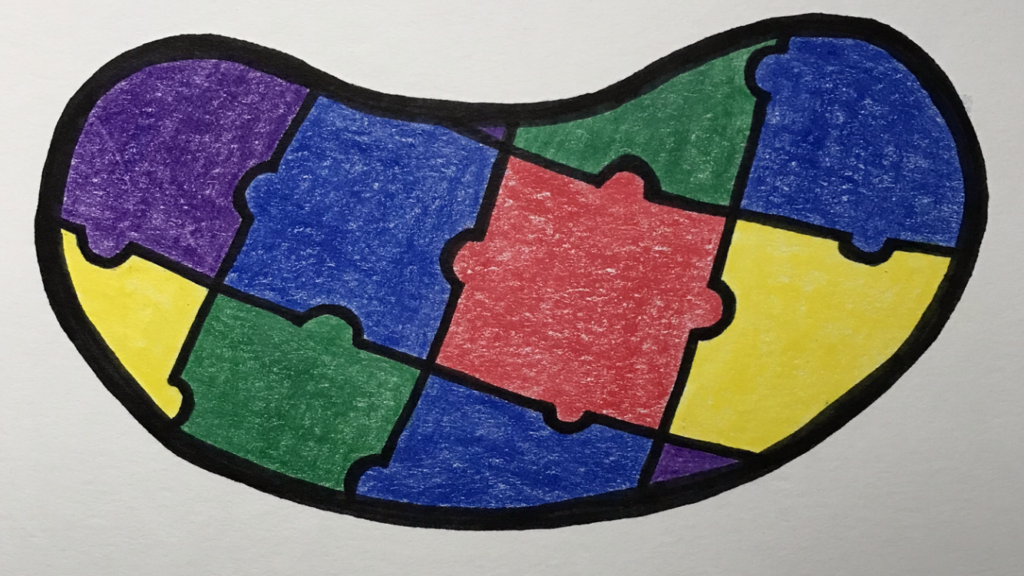
The objective that I chose to explore is “compare and contrast the organelles and their functions”. We’ve learned a tiny bit about mitochondria in this class. Basically, these kidney-shaped microscopic organelles are the “energy transformers” of our cells. More specifically, they turn stored energy into adenosine triphosphate (ATP), which is the energy form that our cells need and use continuously (textbook, p. 101). My curiosity was sparked to explore what would go wrong with our bodies if our mitochondria malfunctioned. I figured that because mitochondria are directly related to energy, the main symptom of problems with them would be low energy. It turns out that it’s not that simple. I was very impressed to discover that there are more than a handful of specific mitochondrial diseases, including Kearns-Sayre syndrome, Leigh syndrome, and myoclonus epilepsy with ragged red fibers (5). Pretty much the whole body can be adversely affected, including the nervous system, organs, tissues, and senses (4). I researched and focused on the suspected connection between mitochondria malfunction and autism spectrum disorder, and my art project is a mitochondrion-shaped outline filled with a spectrum of colored puzzle pieces inspired by the autism logo.
First of all, I tried to find a simple definition of what autism spectrum disorder (ASD) is. The CDC states that ASD, a disorder that affects approximately 2 percent of American children, is a “developmental disability caused by differences in the brain” (5). As is the case with mitochondrial disorders, ASD is a much more complicated situation, though, than it would first appear to be; the CDC definition was severely oversimplified. A group-written article from the National Library of Medicine does a better job of explaining that autism is a neurodevelopmental and neuropsychiatric disorder, and I read there that it is multifaceted and usually involves issues with more than one organ per person (2). As is represented by the rainbow of colors found in autism logos, this disorder does not discriminate; it affects all ages, all walks of life, and affects some people a little bit while severely impacting daily life for others (7).
My next step was to find which symptoms of ASD overlap with symptoms of mitochondrial diseases; they are numerous. Neurologically, both categories include seizures and ADHD symptoms like hyperactivity or inattention. Gastrointestinal issues such as constipation are another commonality. Mitochondrial diseases and ASD can both create sensory issues and muscular problems (5, 6). I even easily found a list of mitochondrial disease symptoms that includes autistic spectrum cognitive issues as one of its items (4). Because ASD can affect such a wide range of organs and bodily functions, it is not a stretch to consider that the disorder is sourced at a cellular level. In fact, one study showed that up to 80 percent of children with ASD evidenced mitochondrial dysfunction; tests have shown that ASD is clearly related to the physiological markers of abnormal mitochondria (1).
Scientists are still working on discovering all of the causes of ASD. In fact, the interlocking puzzle pieces that are in autism logos are meant to demonstrate that there is still much that is unknown about autism (7). While genetics are certainly a factor, much more investigation is needed (1). Research is clearly showing that the lack of properly functioning mitochondria can be a contributor or indicator. More specifically, it has actually been found that mitochondrial dysfunction is one of the most common metabolic disorders in patients who are challenged with the diagnosis of ASD (3). While what I’ve discovered in my research for this project exposed just a tiny little fraction of the world of mitochondria, I am nonetheless humbled by the importance of such a tiny little organelle.

This piece is an illustration of a mitochondria shape with the ASD logo inside to highlight the direct correlation of the mitochondria to ASD. Ms. Witt also discusses interesting findings of what causes ASD and other mitochondria disorders, Witt gives has hypothesis of what a mitochondrial disorder would look like and then goes into backed up, factual symptoms of mitochondrial disorders. There is a great definition of what ASD is and is very helpful to understand what the subject is.
As for the actual art piece it is simple, yet holds a lot of power. The pieces represent all of the different pieces of ASD that are being connected as researchers learn more and more about the disorder, the also symbolize that ASD is something that can affect anyone, young kids, adults, men and women all together. The mitochondria shape is showing what might be the cause of ASD and representing that cell makeup is what can cause ASD.